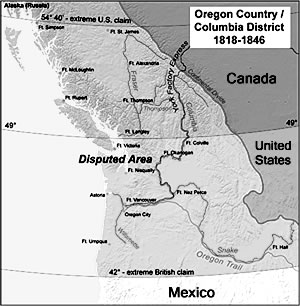The Oregon Territory was the located in the region west of the continental divide in the Rocky Mountains. It lay between the 42nd parallel, the northern boundary of California, and the 54°-40’ line, the southern boundary of Alaska, including all or parts of future states of Washington, Oregon, Idaho, Wyoming and Montana and the Canadian province of British Columbia. Both sides had long-standing claims, the claims of the United States having originated with the Lewis and Clark expedition.
 In 1841 Congress considered a bill for construction of forts along the Oregon Trail, and for generous land grants. British Foreign Secretary Lord Palmerston declared in Parliament that passage of the bill “would be a declaration of war.” Secretary of State John Calhoun urged restraint, arguing that the settlers moving into the territory of their own free will would solve the problem. The bill did not pass. Webster and Ashburton avoided issue while arriving at their treaty in 1842, feeling that other issues were more pressing. About that time “Oregon fever” set in, a result of the panic of 1837 and the attractiveness of rich farmland that could be cultivated year-round. Slavery had not penetrated the Oregon area, which Northeasterners also found appealing. As California still belonged to Mexico, the only outlet for Americans on the west coast was Oregon, which had been occupied jointly with the British since 1818. The area in dispute in the early 1840s lay between the Columbia River and the 49th parallel.
In 1841 Congress considered a bill for construction of forts along the Oregon Trail, and for generous land grants. British Foreign Secretary Lord Palmerston declared in Parliament that passage of the bill “would be a declaration of war.” Secretary of State John Calhoun urged restraint, arguing that the settlers moving into the territory of their own free will would solve the problem. The bill did not pass. Webster and Ashburton avoided issue while arriving at their treaty in 1842, feeling that other issues were more pressing. About that time “Oregon fever” set in, a result of the panic of 1837 and the attractiveness of rich farmland that could be cultivated year-round. Slavery had not penetrated the Oregon area, which Northeasterners also found appealing. As California still belonged to Mexico, the only outlet for Americans on the west coast was Oregon, which had been occupied jointly with the British since 1818. The area in dispute in the early 1840s lay between the Columbia River and the 49th parallel.
Most Easterners didn’t care about the land west of the Rockies, at least until the 1849 gold rush, but some saw it as a gateway to the Orient and trade. One campaign slogan among expansionists in 1844 election had been “54-40 or fight,” meaning that America wanted the entire Oregon territory for itself. The coming of the Mexican War made it clear that President Polk was in no position to fight Great Britain. At the same time Great Britain did not want war with the United States over a remote area with little British population.
In 1845 the Oregon issue was also tied to Texas as part of the regional balance over slavery. Then President Polk asserted the U.S. claim in his inaugural address, irritating the British further. Polk offered to settle the dispute along the 49th parallel, but the British refused. Polk thereupon reverted to demanding the 54°-40’ line, but he was probably bluffing. Meanwhile, internal British political upheavals caused a reevaluation, and the 49th parallel was again offered and agreed upon. President Polk referred the matter to the Senate, which recommended acceptance. The treaty passed 41-14, a reasonable solution—with no bloodshed.